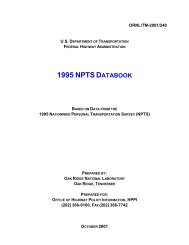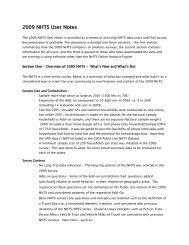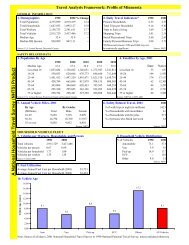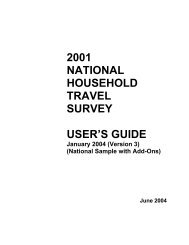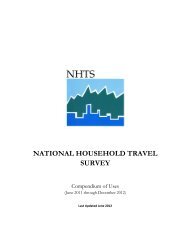Uses of National Household Travel Survey Data in - NHTS Home ...
Uses of National Household Travel Survey Data in - NHTS Home ...
Uses of National Household Travel Survey Data in - NHTS Home ...
Create successful ePaper yourself
Turn your PDF publications into a flip-book with our unique Google optimized e-Paper software.
Special Population Groups<br />
Trip-Cha<strong>in</strong><strong>in</strong>g Behavior <strong>of</strong> Older People: Effects <strong>of</strong> Medical Conditions and Urban Form<br />
Authors:<br />
Noland, Robert B; Schmocker, Jan-Dirk; Bell, Michael G H<br />
Transportation Research Board - 500 Fifth Street, NW Wash<strong>in</strong>gton, DC 20001<br />
TRB 87th Annual Meet<strong>in</strong>g Compendium <strong>of</strong> Papers DVD<br />
Transportation Research Board 87th Annual Meet<strong>in</strong>g<br />
2008<br />
Abstract:<br />
This paper exam<strong>in</strong>es the relationship between the trip complexity <strong>of</strong> older people <strong>of</strong> (60 years and older),<br />
as measured by the number <strong>of</strong> stops they make <strong>in</strong> a tour. The data used for this analysis is the tripcha<strong>in</strong><strong>in</strong>g<br />
dataset <strong>of</strong> the 2001 <strong>National</strong> <strong>Household</strong> <strong>Travel</strong> <strong>Survey</strong>, which is a comprehensive survey <strong>of</strong><br />
travel behavior <strong>in</strong> the United States. Our analysis focuses on understand<strong>in</strong>g the difference <strong>in</strong> the behavior<br />
<strong>of</strong> older people compared to earlier work done on this same data for the entire sample (Noland and<br />
Thomas, <strong>in</strong> press). Our focus is both on exam<strong>in</strong><strong>in</strong>g the effect <strong>of</strong> urban form, as proxied by population<br />
density, and the effect <strong>of</strong> medical conditions <strong>of</strong> older people on their travel. We break down the age<br />
cohorts <strong>in</strong>to sub-groups that span the range <strong>of</strong> our population <strong>of</strong> those older than 60. This helps <strong>in</strong><br />
understand<strong>in</strong>g dist<strong>in</strong>ctions between the travel <strong>of</strong> the “old-old” and the “young-old”. An ordered probit<br />
model is used to conduct a multivariate analysis <strong>of</strong> these effects on trip complexity. Our results yield<br />
some <strong>in</strong>terest<strong>in</strong>g f<strong>in</strong>d<strong>in</strong>gs and both similarities and differences <strong>in</strong> the travel behavior <strong>of</strong> older people<br />
compared to the entire sample.<br />
Subject areas and Index Terms<br />
Highways; Plann<strong>in</strong>g and Forecast<strong>in</strong>g; Safety and Human Factors; Society; I72: Traffic and Transport<br />
Plann<strong>in</strong>g<br />
Age groups; Aged; Diseases and medical conditions; Health; Health care; Population density; <strong>Travel</strong><br />
behavior; Trip cha<strong>in</strong><strong>in</strong>g; <strong>National</strong> <strong>Household</strong> <strong>Travel</strong> <strong>Survey</strong><br />
Availability: Transportation Research Board Bus<strong>in</strong>ess Office<br />
28



